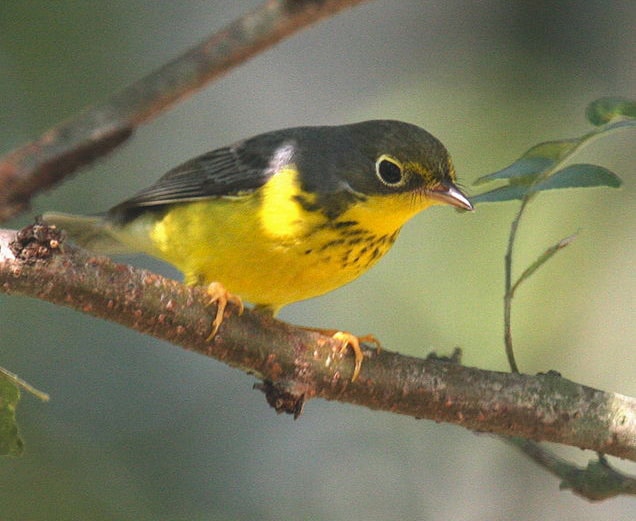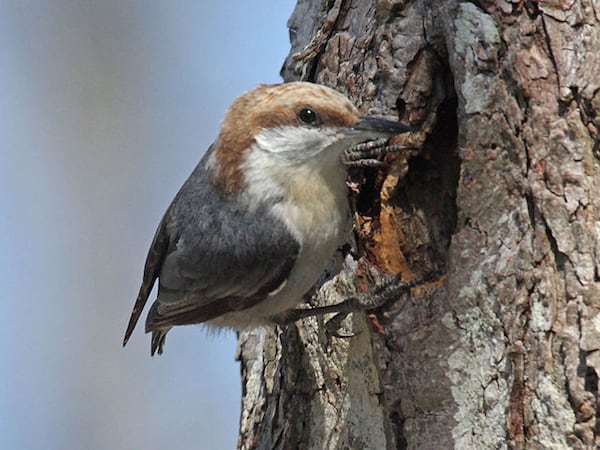I like birding in places where there are only 22 people per square mile. Especially when the birds vastly outnumber the bird watchers, and many of those birds are some of the most sought-after species in North America.
Welcome to Presque Isle County, Michigan, a true avian Eden. This northern Michigan paradise is so rich in biodiversity, and so little visited by the binocular-toting crowd, that I admit to having a bit of trepidation about penning this article. It’s nice to have secret spots, but this place is just too hot to keep under my hat.
Wedged into the northeastern corner of Michigan’s Lower Peninsula, Presque Isle County is buffered by the clear waters of Lake Huron to the east, our second-largest Great Lake. A short float across the Straits of Mackinac to the north, and you’re in the wilds of the Upper Peninsula.
Bird watchers largely bypass Presque Isle County. Kirtland’s warbler–seekers stop short about 50 miles to the south, in the famed jack pine belt that stretches between Grayling and Mio along the Au Sable River. Those questing for boreal species blow right by, and into the Wolverine State’s northernmost reaches. Sand-lovers veer to the western side of the Lower Peninsula, to scramble about the massive Sleeping Bear dunes.
And gorgeous Presque Isle County goes largely unnoticed. I certainly wasn’t familiar with the region, when Christine Baideme of NettieBay Lodge invited me up to teach a bird-watching workshop. My pre-trip research indicated plenty of potential, and by the time I rolled north in late May of last year, I was plenty excited by the prospects.
As I passed through the botanical tension zone north of Saginaw, where a dramatic shift toward boreal forests begins, traffic cleared out and the landscape became increasingly wilder. Heading north on Route 33, not far south of the quaint town of Onaway, I was thrilled to note large expanses of jack pine, less than one-half hour from NettieBay Lodge. “Ah, the participants in our birding workshop may be in for a treat,” I thought as I resolved to case the pines for a world-famous rarity the next morning.
As I pulled into the NettieBay Lodge drive, I quickly saw that this would not be a weekend of gloom and drudgery. A beautiful natural lake provides the backdrop for the lodge, and the placid waters echo the haunting yodels of common loons. A pair of osprey had stuck their bulky nest of sticks atop a convenient telephone pole, and one of the first songbirds I heard was the local pair of pine warblers. Purple finches and rose-breasted grosbeaks made regular forays to the feeders, and yellow-bellied sapsuckers could be heard rat-a-tat-tatting their distinctive drums.
Come dusk, a male American woodcock sashayed onto the lodge’s lawn and provided an aerial courtship extravaganza directly overhead, which he repeated faithfully every evening. Nightfall brought out the whip-poor-wills, and these loud goatsuckers were sometimes accompanied by the booming hoots and squalls of the resident barred owls. Presque Isle County was looking pretty good, and I hadn’t even ventured away from the lodge yet!
Bright and early the next morning, I headed out to case the area before our birding guests arrived. First stop: that intriguing jack pine forest that I had passed on the way up. As I neared the pines, I swerved off onto a seldom-used sandy track, and I was soon in the thick of a sea of stubby jack pines. Seconds after exiting the car, I was blasted by the loud, reverberating song of a Kirtland’s warbler. Bingo! Our soon-to-arrive bird watchers were in for a major surprise.
A quick stroll down the lane produced several singing Kirtland’s, along with hermit thrushes, Nashville warblers, and vesper sparrows. The odd insectlike buzzes of clay-colored sparrows were all around, and the distant croaks of common ravens and the guttural rattles of sandhill cranes added to the ambiance.
This area was looking pretty darn promising, and I was eager to dip my toes into other habitats. As I exited the jack pines, a richly boisterous song caught my ear, and I stopped to stake out a territorial Lincoln’s sparrow for the next day’s field trip. These neatly plumaged little skulkers become much more extroverted on their breeding grounds, and northern Michigan is at the southern limits.
Passing a lush meadow of hay, I decided I’d better have a look for some of the numerous upland sandpipers that nest locally. I didn’t see any of these odd dovelike shorebirds, but I was rewarded by a cacophony of squeaky gurgles drifting from the sky—the strange R2-D2–like songs of courting bobolinks, the golden-naped males pulling out all the stops to woo the ladies. A sleek, gray male northern harrier floated by, more intent on capturing furry sausages with legs—meadow voles—than concerned with the exuberant bobolinks.
It was high time to enter the boreal forest, a piney realm of black spruce, balsam fir, tamarack, and other coniferous denizens of the North Woods. Birding this habitat soon proved maddening, but only in a way that bird watchers dream about. Each stop produced myriad birds, and decisions. Should I strike out after that mourning warbler? Wait! There’s a Canada warbler. Black-billed cuckoo coo-coo-cooing in the thicket. Never mind that rose-breasted grosbeak singing its slurry, drunken robin tune overhead—they’re everywhere! If I am to be driven mad by excessive birds, please make these cool woods my asylum.
Heading back to NettieBay with an ear canted out the window, I heard the distinctive BZZZ-bzzz-bzzz of a golden-winged warbler and jammed the brakes hard. Leaping into the roadway—there’s hardly any traffic—I scanned the shrubby copse for the little gold-capped, black-bibbed warbler that looks like it’s got a gold ingot tattooed on its wing. Whoa! No golden-wing here—it was a Brewster’s warbler, the intriguing hybrid between golden-winged and blue-winged warblers. The next day, when I brought the group back to fawn over the bird, an apparently pure female golden-winged warbler had joined it. That’s what you call an ornithological double whammy.
Presque Isle County is liberally dotted with pure glacial lakes and sedge-dominated wetlands, and I quickly discovered that these boggy spots were always good for something. American bitterns occupied nearly all of them, and their curious oonk-ah-choonks resonated nearly everywhere that water and plants met. As dusk set in, Pinocchio-billed Wilson’s snipe would rocket skyward and send their eerie quavering oscillations, caused by specially fluted tail feathers, through the skies.
I would be remiss if I didn’t mention a huge bonus of birding Presque Isle County: the plants. Late May brings such a treasure trove of outstanding vegetable matter that even the most botanically jaded would perk up and prostrate themselves on the cool earth. In places, yellow lady’s slipper orchids were—dare I say—roadside weeds. Snow-white panicles of blooms glowed electric from shady woodland margins, courtesy of Labrador tea, a showy shrublet of the North. I was struck dumb by the carpets of gay-wings blanketing forest floors, a tiny milkwort so charming it defies adequate description. Extending perhaps two inches aloft, its tiny pink bracts resemble airplane wings, and the burst of flowers fronting the plant suggests a propeller.
A special treat were rafts of dwarf lake iris in full flower, forming magenta drifts across rocky limestone openings. Its avian counterpart might be the Kirtland’s warbler, as both plant and bird occur in only a limited area of the upper Great Lakes. At one point I felt the vibes of something special and pulled off the road into a dimly lit spruce stand; there I stumbled into three plants of a coveted orchid: the ram’s-head, a diminutive lady slipper. The tiny pouchlike flowers are not much larger than your thumbnail, and the entire plant might be eight inches in height, but all who saw them fell under their spell.
By the time our group arrived, I was ready to share the bounty of a place for which I had already fallen hard. Off we went, exploring woodland, wetland, fen, and river. A meander along Little Ocqueoc River—a stream that plunges underground, only to pop back to the surface elsewhere—produced a winter wren. These pint-sized balls of fluff sing one of the most amazingly complex melodies of any bird, anywhere. Their impossibly ornate symphonies mesh perfectly with the cascading rush of swift brooks lacing dark forests, the Lilliputian wren’s song bringing cheery light to the sylvan gloom. Blue-headed vireos stuttered out slow, sweet phrases overhead, intermixed with the wheezy, breezy zee-zoo-zee of black-throated green warblers.
For two days, our band of adventurers peregrinated about Presque Isle County, delving into all of the habitats that I’ve described, and more. In our all-too-brief foray, we saw 130 species of birds, including 23 warbler species (nearly all breeding), 11 species of sparrows, and 7 species of woodpeckers. Merely recounting numbers doesn’t begin to capture the magic of this place, though. None of us will soon forget the spectacle of a male American bittern, its mate standing close, gulping air and belching out its weird call in plain view. Or the cavelike blackness of a forest road late at night, the spooky red eyeshine of perched whip-poor-wills glowing in our flashlight beams like strange banshees, replete with loud wails. Memorable was an outrageously extroverted Virginia rail. A few blurts from my audio player coaxed him from the bulrushes and up onto the roadway, where he strutted about within a few feet of our group.
An 1839 survey party, contracted by the State of Michigan to decipher the wildlands of soon-to-be Presque Isle County, promptly pronounced the land “worthless” upon completion of their studies. They must not have been bird lovers or botanists. Few places in eastern North America offer the rich bounty of natural delights that Presque Isle County, Michigan, does. I hope you can add it to your travel itinerary.




